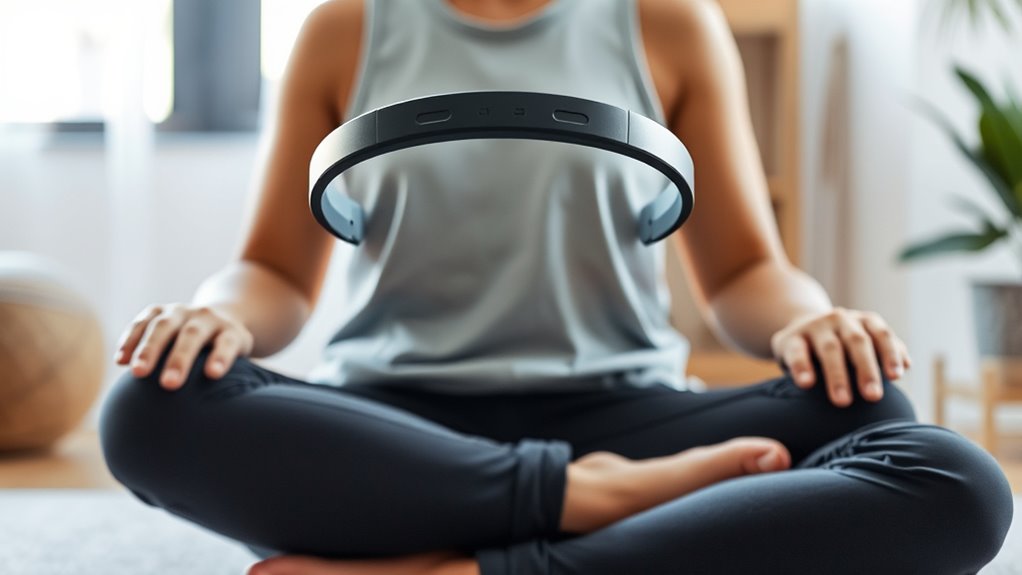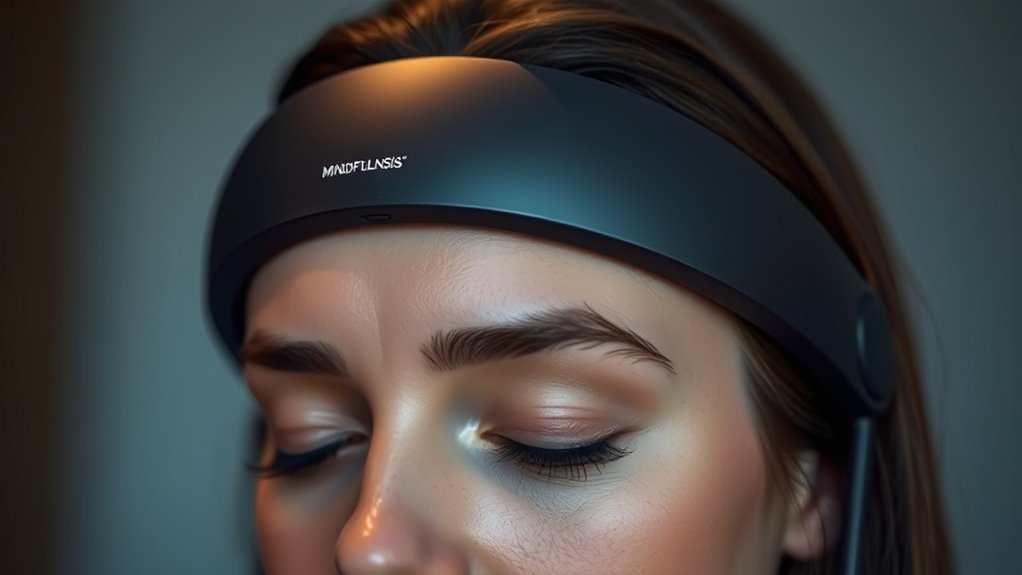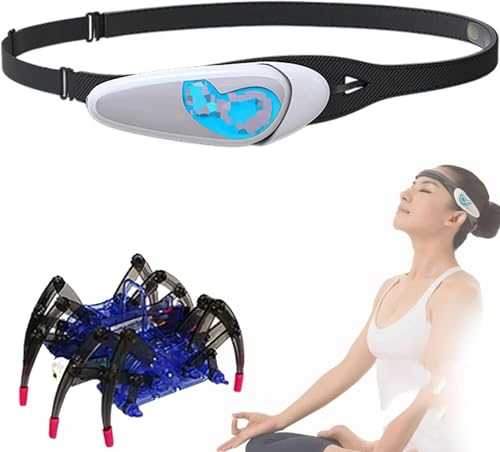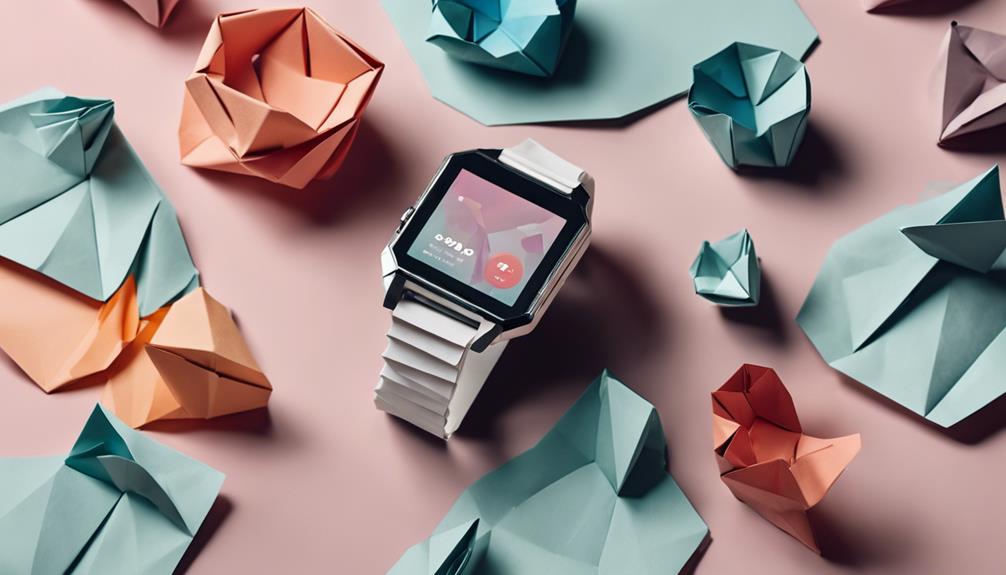If you’re new to meditation and want to boost your focus, brain-sensing headbands can really help. They provide real-time neurofeedback, guiding you to calm and concentrate more effectively. Devices like Muse, Flowtime, and Zendo are popular options, offering comfort, easy connectivity, and engaging features. Each one supports beginners with helpful insights and guidance. Keep exploring, and you’ll discover more about how these headbands can transform your mindfulness journey.
Key Takeaways
- Prioritize headbands with real-time EEG neurofeedback to improve focus and relaxation for beginners.
- Choose devices with comfortable, adjustable designs suitable for extended meditation sessions.
- Look for user-friendly apps and features like guided exercises, progress tracking, and visual cues.
- Consider compatibility with smartphones (iOS/Android) and Bluetooth for seamless connectivity.
- Evaluate durability, sensor quality, and maintenance needs to ensure long-term reliability and value.
MUSE 2 Brain Sensing Headband with Meditation Tracker
If you’re looking for a headband that offers real-time neurofeedback to deepen your meditation practice, the MUSE 2 Brain Sensing Headband is an excellent choice. It uses advanced multi-sensor EEG technology to detect whether your brain is in a distracted or calm state, providing instant feedback through the MUSE app. The device connects via Bluetooth, guiding you with soundscapes, breathing, and heart exercises to enhance focus and relaxation. After each session, you receive a “calm score” to track your progress. Its research-backed design and user-friendly interface make it a powerful tool for building mindfulness, improving mental clarity, and fostering emotional resilience.
Best For: individuals seeking a research-backed, user-friendly device to enhance meditation, mental clarity, and emotional resilience through real-time neurofeedback.
Pros:
- Provides real-time EEG-based neurofeedback to deepen meditation practice and improve focus.
- Connects seamlessly via Bluetooth with guided meditations, soundscapes, and diverse training modes.
- Tracks progress with calm scores, helping users monitor mental wellness over time.
Cons:
- Connectivity issues and sensor contact problems can hinder consistent use.
- Sensor pads may degrade, affecting long-term performance and durability.
- Bright LED lights and app bugs may cause discomfort or frustration during use.
Meditation Headband with EEG Biofeedback Devices
The Meditation Headband with EEG Biofeedback Devices stands out for those who want precise, real-time insights into their brain activity during meditation. It uses advanced sensors to monitor brainwaves like alpha, beta, gamma, theta, delta, and SMR, providing instant feedback on performance, calmness, and focus. The device offers visual and auditory cues that adapt as your practice improves, helping you stay engaged. Compatible with third-party apps, it supports varied meditation styles without extra fees. Its soft, adjustable design ensures comfort, and with up to 8 hours of battery life, you can meditate anywhere. Connecting effortlessly via Bluetooth, it makes mindfulness accessible and effective.
Best For: individuals seeking precise, real-time brain activity insights during meditation to improve focus, calmness, and overall practice quality.
Pros:
- Provides comprehensive brainwave monitoring including alpha, beta, gamma, theta, delta, and SMR waves for detailed feedback.
- Supports seamless integration with third-party apps and offers customizable visual and auditory cues for motivation.
- Comfortable, portable design with long battery life (up to 8 hours) for convenient use anytime and anywhere.
Cons:
- May require some time to interpret and utilize the detailed brainwave data effectively for beginners.
- Advanced sensors and electrodes could increase the device’s cost compared to simpler meditation tools.
- Dependence on Bluetooth connectivity might pose occasional pairing or signal stability issues.
Flowtime Biosensing Meditation Headband for Neurofeedback and Heart Rate Monitoring
For those seeking an all-encompassing at-home meditation tool, the Flowtime Biosensing Meditation Headband stands out by offering real-time neurofeedback and heart rate monitoring. It tracks brainwaves—alpha, theta, beta, gamma—as well as heart rate, HRV, stress, and relaxation levels. The device provides visual feedback during sessions and detailed reports to track progress. Compatible with iOS and Android, it’s lightweight, portable, and easy to use, with Bluetooth connectivity and up to 8 hours of battery life. Whether guided or unguided, it helps users improve meditation skills by showing when they’re in an ideal state, making practice more effective and personalized.
Best For: individuals seeking an at-home, all-in-one meditation device that provides real-time neurofeedback, heart rate monitoring, and progress tracking to enhance their meditation practice.
Pros:
- Offers comprehensive tracking of brainwaves, heart rate, HRV, stress, and relaxation levels for personalized insights.
- Supports both guided and unguided meditation sessions with real-time visual feedback and detailed performance reports.
- Lightweight (29g), portable, with Bluetooth connectivity and up to 8 hours of battery life, making it easy to use anywhere.
Cons:
- Customer ratings are mixed, with an average of 3.4 out of 5 stars, indicating varying user experiences.
- Price and availability may fluctuate, potentially affecting accessibility for some users.
- Limited information on warranty specifics and customer support responsiveness.
Muse: Brain Sensing Headband for Meditation and Brain Activity Monitoring
Curious about how technology can deepen your meditation practice? Muse is a brain sensing headband that offers real-time EEG neurofeedback to help you understand your mental state. When you wear it, connect your device, and start the app, you’re guided into calming sounds like rain or beaches. The headband measures your brain waves and gives instant auditory feedback, showing whether your mind is calm or active. After each session, you review your brain activity, set new goals, and track your progress. Muse makes meditation more accessible and engaging by removing guesswork, helping you develop a calmer, more focused mind.
Best For: individuals seeking to enhance their meditation practice through real-time neurofeedback and brain activity monitoring.
Pros:
- Provides immediate EEG-based feedback to improve meditation focus and relaxation.
- Easy-to-use with app integration and guided sounds for a calming experience.
- Allows post-session review and goal setting to track progress over time.
Cons:
- Requires wearing a headband and connecting devices, which may be cumbersome for some users.
- The effectiveness depends on user engagement and consistent use.
- Might be expensive for casual or beginner meditators compared to traditional methods.
Brainwave Biofeedback Headband for Meditation and Concentration
If you’re looking to improve your meditation practice and boost concentration, a brainwave biofeedback headband can be a game-changer. It offers reliable reports on your progress, helping you deepen meditation and manage stress-related issues like insomnia and high blood pressure. By supporting neurofeedback training, it enhances mental performance over time, especially for children. The headband features fun applications like Brainwave Lie Detector and DIY assembly activities that foster hands-on skills and understanding of brain states. Plus, its cloud-based data tracking allows families to monitor growth and compare scores, making it a versatile tool for both relaxation and cognitive development.
Best For: individuals seeking to enhance meditation, reduce stress, and improve cognitive skills, especially children and families interested in interactive learning.
Pros:
- Provides reliable feedback reports to track meditation progress and mental performance
- Supports engaging DIY assembly activities that promote hands-on learning and understanding of brain states
- Facilitates family involvement with cloud-based data tracking and peer comparison features
Cons:
- May require initial setup and learning to effectively interpret biofeedback data
- Limited to certain applications, which may not cover all advanced neurofeedback needs
- Potential cost barrier for comprehensive use or additional accessories
Biosensing Meditation Headband for Brain Wave Data and Relaxation
The Biosensing Meditation Headband stands out as an ideal choice for anyone seeking to deepen their meditation practice and reduce stress through real-time brain wave data. I find its ability to provide reliable reports on meditation progress incredibly helpful, especially for stress relief and mental clarity. With features like brainwave monitoring, game-based exercises, and lie detection, it makes practicing meditation engaging and interactive. I also appreciate its self-assembly aspect, which helps users understand brain states and mechanical principles. Whether for children or adults, it’s a versatile device that promotes focus, emotional balance, and relaxation, making every session more effective and enjoyable.
Best For: individuals of all ages seeking to enhance meditation, reduce stress, and improve mental focus through interactive brain wave monitoring and engaging exercises.
Pros:
- Provides reliable and detailed reports on meditation progress, aiding stress reduction and mental clarity
- Supports interactive games and lie detection for engaging and fun neurofeedback training
- Encourages self-assembly and understanding of brain states, fostering hands-on learning and parent-child interaction
Cons:
- Requires careful handling and proper sensor placement to ensure accurate readings
- Limited continuous use time of 2-3 hours per charge, necessitating frequent recharging for extended sessions
- Disassembled Spider Robot assembly may be challenging for some users without proper guidance
Mindsight Guided Meditation Breathing Tool
Mindsight Guided Meditation Breathing Tool stands out for its simple, app-free design, making it an ideal choice for beginners and visual learners who want an easy, guided way to practice mindful breathing. Its compact, soft silicone Buddha figure uses fade-in and fade-out color cues to guide breathing patterns like 4/7/8 or box breathing, without any sound or moving parts. You just tap to adjust brightness or switch modes. It’s perfect for use at home, work, or bedtime, helping reduce stress, promote relaxation, and cultivate present-moment awareness. With a rechargeable battery lasting up to two months, it offers a straightforward, calming tool for daily mindfulness practice.
Best For: individuals seeking an easy, visual, and app-free mindful breathing tool to reduce stress, enhance relaxation, and develop present-moment awareness at home, work, or bedtime.
Pros:
- Simple, intuitive operation with no app or sound needed
- Compact, soft silicone design that’s tactile and visually calming
- Long-lasting rechargeable battery with up to two months of use
Cons:
- Limited programming options for customized breathing patterns
- No built-in timer, so users may need additional tools for session timing
- Might be considered small or less feature-rich compared to electronic devices with more functions
Imagine Meditation Cards for Kids
Imagine Meditation Cards for Kids stands out as an engaging mindfulness tool designed specifically for children aged 4 to 17. This award-winning kit features large, colorful cards with calming guided meditations, promoting focus, relaxation, and emotional resilience. It includes 24 rich scripts, a breathing exercise, and DIY cards for kids to personalize their practice. The set encourages parent-child bonding and can be used at home, school, or therapy sessions. Its versatile format makes mindfulness accessible and fun for children, helping them develop essential coping skills while fostering inner peace. It’s a meaningful gift that makes learning mindfulness enjoyable and engaging for kids of all ages.
Best For: parents, teachers, therapists, and caregivers seeking a fun, effective mindfulness tool to help children develop emotional resilience, focus, and relaxation skills.
Pros:
- Engaging and colorful XL cards with guided meditations suitable for a wide age range (4-17).
- Promotes parent-child bonding and can be used in various settings like home, school, and therapy.
- Includes additional features like a breathing exercise and DIY cards for personalized practice.
Cons:
- The set may be too large for very young children to handle independently without adult supervision.
- Some children might prefer digital or app-based mindfulness tools over physical cards.
- The effectiveness depends on consistent use and adult guidance, which may require commitment.
Imagine Meditation Kit for Kids
Designed specifically for children aged 4 and up, the Imagine Meditation Kit offers a fun and engaging way to introduce mindfulness and emotional regulation. It includes 24 sturdy, vibrant cards that guide kids through calming meditations, affirmations, and breathing exercises. The kit features a legend card to help children or adults choose appropriate activities for different feelings or challenges, along with an easy navigation aid for quick access. Perfect for use at home, in the classroom, or during therapy, it promotes focus, relaxation, and emotional growth, making mindfulness accessible and enjoyable for young children and their caregivers.
Best For: parents, teachers, and therapists seeking a fun, effective tool to introduce mindfulness and emotional regulation to children aged 4 and up.
Pros:
- Engaging, vibrant cards that capture children’s attention and promote relaxation.
- Versatile for use at home, in classrooms, or during therapy sessions.
- Supports emotional development and self-awareness with easy-to-follow guided meditations and affirmations.
Cons:
- May require adult guidance for younger children to fully benefit from the meditations.
- Limited to 24 cards, which might not cover every emotional challenge or preference.
- The size and weight may be less portable for on-the-go use compared to digital options.
Meditation Cards for Kids – Mindfulness and Relaxation Activities
Kids aged 4-10 will find these Meditation Cards engaging and easy to use, thanks to their colorful watercolor illustrations and simple instructions. I love how the 31 laminated cards promote emotional wellbeing through guided meditations, breathing exercises, visualizations, and affirmations. Their sturdy design guarantees they last through frequent use, whether in classrooms, therapy, or at home. The color-coded categories make it easy for children and adults to find activities suited to different needs, from calming down to setting goals. These cards are practical tools that help kids express feelings, reduce anxiety, and build mindfulness skills in a fun, accessible way.
Best For: parents, teachers, and therapists seeking a durable, colorful, and easy-to-use tool to promote emotional wellbeing and mindfulness in children aged 4-10.
Pros:
- High-quality, laminated cards with vibrant watercolor illustrations that are engaging for children
- Color-coded categories for easy navigation and selecting appropriate activities for different needs
- Versatile and suitable for various settings including classrooms, therapy sessions, and home environments
Cons:
- May require guidance or supervision to maximize the benefits of activities for younger children
- The set might be less engaging for children outside the targeted age range of 4-10
- Some users might prefer digital or interactive formats over physical cards
Zendo Meditation Headband – Unlock The Benefits of Meditation Immediately
If you’re looking to deepen your meditation practice quickly and effectively, the Zendo Meditation Headband stands out as one of the best options. Its sleek, Apple-like design feels comfortable and secure, fitting snugly without movement. The upgraded version offers longer battery life, smoother pulses, and an intuitive app that’s easy to pair with your iPhone. Users report feeling deep relaxation within just minutes, helping them focus and quiet their minds faster. While ongoing costs for disposable pads are a consideration, the technology’s scientific backing and user satisfaction make Zendo an accessible, powerful tool for both beginners and seasoned meditators seeking immediate benefits.
Best For: individuals seeking a stylish, comfortable, and scientifically backed meditation aid that facilitates rapid relaxation and improved focus for both beginners and experienced meditators.
Pros:
- Sleek, Apple-like design that is both attractive and comfortable to wear
- Scientific research supporting its safety and effectiveness, with smooth pulses aiding quicker relaxation
- Easy pairing with iPhone and intuitive app controls for customizable meditation sessions
Cons:
- Disposable pads may incur ongoing costs and generate waste, which could be inconvenient for regular users
- Some users experience product failure after limited use, possibly due to defective units or misunderstanding of pad consumability
- Limited manual control over settings and potential app bugs may restrict customization and ease of use
BrainLink Lite Pro Portable Brainwave Sensor Headband for Children and Adults
The BrainLink Lite Pro stands out as a versatile brainwave sensor headband suitable for both children and adults who want to improve focus, relaxation, and stress management. Its portable design and Bluetooth connectivity make it easy to use during meditation or daily activities. Equipped with EEG and EMG sensors, it offers over 20 neuro-gaming apps to visualize and track brain activity, supporting deep meditation, impulse control, and nervous system regulation. The adjustable, comfortable fit and durable build ensure reliable performance. Despite mixed reviews, it remains a popular choice for those seeking scientific insights into their mental states and enhanced mental training.
Best For: individuals of all ages seeking to enhance focus, relaxation, and stress management through scientific brain training and neurofeedback.
Pros:
- Portable and lightweight design for easy use during meditation or daily activities
- Equipped with EEG and EMG sensors and over 20 neuro-gaming apps for engaging brainwave visualization and tracking
- Adjustable fit and durable build ensure comfort and reliable performance
Cons:
- Low customer rating of 2.0 out of 5 stars indicates potential quality or usability issues
- Limited information on app compatibility and software updates may affect user experience
- Short battery life of approximately 2.17 hours could require frequent recharging during extended use
Factors to Consider When Choosing Brain‑Sensing Meditation Headbands for Beginners

When selecting a brain-sensing meditation headband as a beginner, I focus on several key factors that make the experience smoother. I look for models that are compatible with my devices, easy to operate, and comfortable to wear for extended periods. Additionally, I consider battery life and the accuracy of the data to guarantee I get reliable feedback during my practice.
Compatibility With Devices
Choosing a brain-sensing meditation headband that works well with your devices is essential for a smooth experience. First, make sure it’s compatible with your smartphone’s operating system—whether iOS or Android—to avoid connectivity issues. Check if your device supports Bluetooth 4.0 or higher, which ensures a stable wireless connection. It’s also important to verify that the headband pairs easily with your preferred meditation or health apps without needing extra hardware. Additionally, see if it supports third-party apps, giving you more flexibility in your meditation practices. Finally, review the manufacturer’s specifications to confirm the headband’s connectivity features align with your device’s hardware and software. This proactive approach helps prevent frustration and guarantees seamless integration.
Ease of Use
A beginner-friendly brain-sensing meditation headband should have a simple, intuitive interface that makes setup quick and navigation easy. Look for devices with straightforward wearing instructions and fast calibration to prevent frustration early on. Clear visual or auditory feedback that’s easy to interpret helps beginners understand their progress without needing technical expertise. A lightweight, comfortable design ensures you can wear it for extended periods without discomfort, encouraging consistent practice. Additionally, choose a headband that requires minimal maintenance—such as disposable sensors or easy-to-clean components—so you can focus on your meditation rather than fussing with the device. Overall, ease of use is key to making your meditation journey smooth and enjoyable from the very first session.
Comfort and Fit
Comfort and fit are essential factors because even the most advanced brain-sensing headband won’t be effective if it’s uncomfortable or poorly fitting. A good headband should have adjustable straps or flexible materials that guarantee a secure fit without putting pressure on your head. Lightweight designs, ideally under 200 grams, help prevent fatigue and make longer meditation sessions more enjoyable. Soft, breathable padding or fabric sensors add extra comfort, especially if you plan to meditate for extended periods or during sleep. Proper sizing options or adjustable circumference ranges, like 47cm-60cm, assure a snug yet gentle fit for different head sizes. When it fits well, the headband stays in place, maintains consistent contact with your scalp, and provides accurate brainwave data.
Battery Life
When selecting a brain-sensing meditation headband, battery life plays a crucial role in ensuring your practice isn’t interrupted. A longer battery life means you can meditate for extended periods without constantly recharging, which is especially helpful for daily routines. Most headbands offer between 4 to 8 hours of continuous use on a single charge, enough for most meditation sessions. Some models feature standby modes that last several days, reducing the need for frequent charging. Quick-charging options are also beneficial, allowing you to reach full capacity in under an hour if you’re in a rush. Ultimately, good battery life enhances convenience and reliability, making it easier to stick to your meditation schedule, whether you meditate multiple times a day or during travel.
Data Accuracy
Choosing a brain-sensing headband that delivers accurate data is essential for beginners aiming to improve their meditation practice. High-quality sensors and multi-channel EEG technology are key, as they precisely detect brainwave activity. Proper sensor placement and good contact with the scalp are crucial, as poor fit can lead to unreliable readings. Signal processing algorithms and filtering techniques help minimize noise and artifacts, ensuring the data is trustworthy. Regular calibration and firmware updates also play a vital role in maintaining accuracy over time and across sessions. Devices equipped with advanced hardware and validated neurofeedback protocols tend to provide more precise and actionable insights. Focusing on these factors ensures you’re basing your practice on reliable data, making your meditation sessions more effective and enjoyable.
Cost and Maintenance
Prices for brain-sensing headbands can vary widely, from budget-friendly models around $50 to high-end devices exceeding $300. Keep in mind, many devices have ongoing costs like sensor pads, batteries, or subscription features, which can add up over time. Replacing sensor pads or electrodes periodically is necessary due to wear, increasing long-term expenses. Battery life also plays a role; some models offer up to 8 hours per charge, reducing the need for frequent recharging. Regular cleaning of sensors and headbands is recommended to maintain accuracy and extend device lifespan, often requiring specific cleaning supplies. When choosing a headband, consider both initial cost and potential ongoing expenses to ensure it fits your budget and maintenance preferences.
Frequently Asked Questions
Are Brain-Sensing Headbands Suitable for Children and Seniors?
Yes, brain-sensing headbands can be suitable for children and seniors, but with caution. I recommend choosing models designed specifically for their age group, ensuring comfort and safety. It’s crucial to consult a healthcare professional before use, especially for seniors or children with health concerns. These headbands can help improve focus and relaxation if used properly, but supervision and guidance are key for maximum and safe benefits.
Can These Devices Track Sleep Patterns and Improve Sleep Quality?
I was surprised to discover that many brain-sensing headbands do track sleep patterns and can help improve sleep quality. As I used one, I noticed how it provided insights into my sleep cycles, helping me identify disruptions and adjust my habits. These devices often offer tailored recommendations, making it easier to develop better sleep routines. If you’re struggling with sleep, I highly recommend trying one to see the benefits firsthand.
How Accurate Are Brainwave Readings Compared to Clinical EEGS?
Brainwave readings from these headbands are generally less accurate than clinical EEGs. While they provide useful insights into your mental state and relaxation levels, they use fewer sensors and have limited precision. I find them helpful for tracking trends and improving meditation habits, but for detailed, reliable medical data, a professional EEG is still the gold standard. So, consider these headbands as tools for personal growth, not medical diagnosis.
Do These Headbands Require Wi-Fi or App Connectivity to Function?
No, these headbands don’t need Wi-Fi or app connectivity to work; they’re like a self-sufficient tool. You can use them offline, focusing on your meditation without interruptions. However, connecting to a smartphone app can enhance your experience by providing feedback and tracking progress. So, it depends on how much guidance you want—if you’re comfortable without extra features, you can meditate unplugged and still get good results.
What Is the Typical Battery Life for Most Brain-Sensing Meditation Headbands?
Most brain-sensing meditation headbands typically last between 5 to 12 hours on a single charge. I find that the battery life varies depending on the model and usage, especially if you’re using features like continuous EEG monitoring or Bluetooth connectivity. I recommend checking each device’s specifications before purchasing and making sure to charge it overnight if you plan to use it daily. It’s always good to have a backup charger handy!
Conclusion
Finding the right brain-sensing headband is like discovering the perfect compass for your meditation journey. Each option offers unique features to guide you toward better focus and relaxation. Remember, the best headband is the one that feels like a natural extension of your practice, helping you navigate the inner landscape of your mind. So, take your time, explore your options, and let your mindfulness adventure unfold with confidence.






















